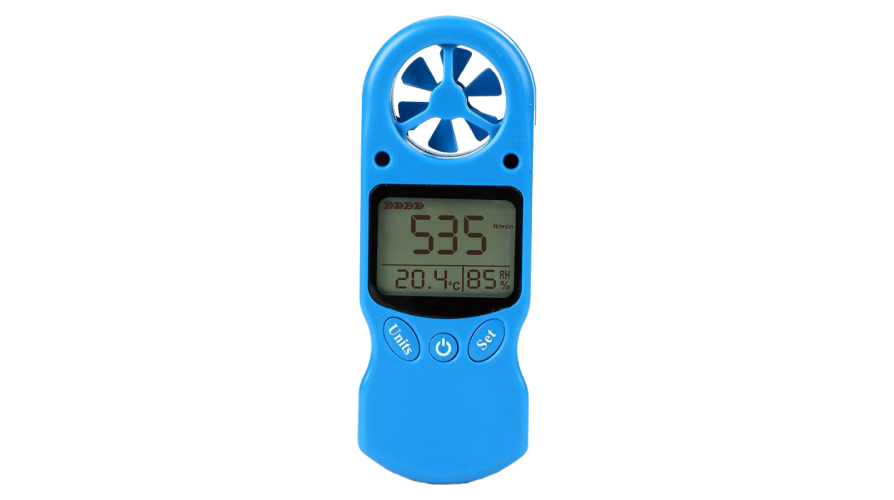How to Keep and Look After Your Anemometer to Make Sure Durability
Wiki Article
Anemometers Unveiled: Recognizing Their Importance in Ecological Monitoring and Security Procedures
The function of anemometers in ecological surveillance and security procedures is typically ignored, yet their significance is undeniable. These instruments have a long history rooted in scientific query and technological advancements, developing to become essential devices in different areas. From meteorology to air travel security, anemometers play an essential role in giving accurate data that educates decision-making processes and enhances general safety and security. Recognizing the details of anemometers unveils a globe of important insights that are basic to our understanding of the environment and the procedures we require to ensure security.History of Anemometers
The advancement of anemometers can be traced back to the ancient worlds where primary wind measuring gadgets were initial used. One of the earliest recognized anemometers was the hemispherical mug anemometer invented by Leon Battista Alberti in the 15th century.In the 18th century, the prominent researcher John Thomas Romney Robinson presented the Robinson anemometer, which featured four hemispherical mugs mounted on horizontal arms that extended from a central axis. This layout became a standard in atmospheric measurements as a result of its precision and reliability. Throughout the years, developments in technology resulted in the development of even more modern-day anemometers, consisting of ultrasonic anemometers and laser Doppler anemometers, providing raised accuracy and efficiency in gauging wind rate and instructions. The history of anemometers showcases an impressive journey of technology and progress in the field of meteorology.
Kinds of Anemometers
Throughout the area of meteorology, various kinds of anemometers have actually been established to accurately gauge wind rate and direction. Sonic anemometers make use of ultrasonic signals to determine wind speed and instructions properly. Hot-wire anemometers operate based on the concept that the cooling effect of wind on a heated wire is symmetrical to the wind rate.Applications in Weather Forecasting
Having gone over the various kinds of anemometers utilized in weather forecasting for determining wind rate and direction, it is necessary to explore their sensible applications in the field. Anemometers play a vital role in meteorology by providing accurate and real-time information on wind problems (anemometer). Meteorologists utilize anemometers to keep track of wind speed and instructions to forecast climate patterns, concern cautions for serious climate occasions like cyclones, hurricanes, and tornados, and examine weather for aeronautics securityIn weather forecasting, anemometers aid in recognizing neighborhood and local wind patterns, which are vital for forecasting climate modifications and figuring out weather patterns. These gadgets are additionally utilized in study to research microclimates, urban warm islands, and air pollution diffusion. Furthermore, anemometers are employed in farming to enhance plant administration methods, such as watering and pesticide application, based on wind problems.
Value in Aviation Security
An integral aspect of making certain air travel security depends on the careful tracking of wind problems making use of anemometers. Anemometers play an essential duty in aviation by providing real-time data on wind speed and direction, assisting pilots in making educated decisions throughout flight, liftoff, and landing. Unforeseeable and strong winds can considerably affect aircraft operations, making it find out here now important for more helpful hints air travel authorities to depend on accurate wind dimensions to make sure the security of travelers and crew.
In the vibrant environment of aeronautics, where also minor adjustments in wind speed and instructions can have extensive effects, anemometers stand as important tools for promoting risk-free and safe air travel.
Role in Environmental Research Study
Exactly how her explanation do anemometers add to advancements in ecological research study? Anemometers play an important duty in ecological study by providing crucial information on wind rate and direction. This info is essential for comprehending numerous atmospheric procedures, such as air pollution diffusion, climate patterns, and climate adjustment. By properly measuring wind attributes, anemometers assist scientists analyze the motion of toxins airborne, analyze the impact of commercial discharges, and anticipate the spread of pollutants in the atmosphere.

Verdict
In conclusion, anemometers have played a vital function in ecological tracking and security actions. Comprehending the importance of anemometers is vital for properly determining wind rate and instructions, which is important for predicting weather condition patterns, ensuring secure aviation operations, and performing ecological researches.One of the earliest known anemometers was the hemispherical cup anemometer developed by Leon Battista Alberti in the 15th century. Over the years, advancements in technology led to the growth of even more contemporary anemometers, including ultrasonic anemometers and laser Doppler anemometers, offering boosted accuracy and efficiency in determining wind speed and direction. Hot-wire anemometers run based on the concept that the cooling effect of wind on a warmed cable is proportional to the wind speed. Meteorologists use anemometers to monitor wind speed and instructions to forecast weather patterns, concern warnings for extreme climate occasions like tornadoes, tornados, and storms, and examine atmospheric problems for air travel safety and security.
Comprehending the significance of anemometers is important for properly measuring wind speed and instructions, which is essential for anticipating weather patterns, making certain safe aeronautics procedures, and conducting environmental research studies. (anemometer)
Report this wiki page